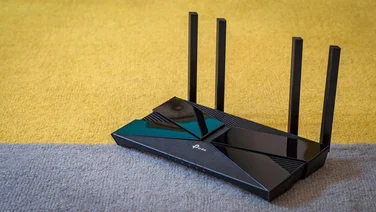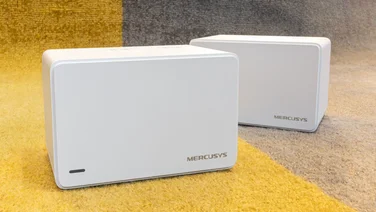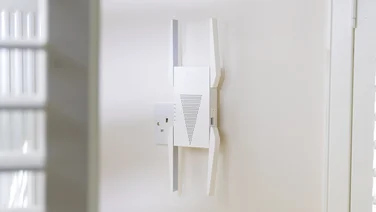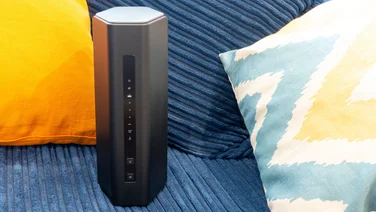To help us provide you with free impartial advice, we may earn a commission if you buy through links on our site. Learn more








- Convenient size and design
- Supports NFC and band splitting
- Plenty of Ethernet ports
- Mobile app feels clunky
- Not particularly speedy
We rather like the Huawei Wi-Fi Mesh 7 (£270) – a simple Wi-Fi 6 mesh that provides good performance at a mid-market price. And for those on a tighter budget the Mesh 3 offers a similar experience in a smaller package. It doesn’t have as much bandwidth, since it uses a dual-band radio array rather than a tri-band one but you do get three stations for the very reasonable sum of £200.
While the Huawei Mesh 3 can’t match the speeds of pricier systems, it provides respectable coverage and has a few nice features – in terms of both hardware and software – that could make it an appealing choice for the price.
Huawei Wi-Fi Mesh 3 review: What you need to know
The Mesh 3 is a three-node Wi-Fi 6 mesh system. Each station has twin radios: a 2.4GHz radio rated at up to 574Mbits/sec and a faster 5GHz radio capable of connection speeds up to 2.4Gbits/sec. While that’s pretty fast, the 5GHz radio has to do double duty, handling traffic to and from your connected devices while also forwarding data between stations as needed. More expensive tri-band systems such as the Mesh 7 use a separate radio for backhaul, so there’s no need to share bandwidth.








The design of the stations is almost identical to the Mesh 7 units but these ones are smaller, with only three Ethernet sockets at the rear rather than four. Huawei claims these three units will deliver the same coverage as two of the larger models, up to a total of 600 square metres.
Unsurprisingly, the Mesh 3 doesn’t support the newest Wi-Fi 6E standard – we’ve only seen a handful of routers and meshes that do – but it will still work with 6E-compatible devices, using a regular Wi-Fi 6 connection. You can also connect older computers and phones that use Wi-Fi 5 or even the ageing 802.11n standard, although these won’t get the full performance the Mesh 3 is capable of.
READ NEXT: Our round-up of the best mesh Wi-Fi routers
Huawei Wi-Fi Mesh 3 review: Price and competition
While the Mesh 3 is a very affordable mesh system, it isn’t the cheapest we’ve tested. The Tenda Nova MW3 offers three units for a ridiculously low £60, although that’s only really suitable for light use: we’re talking maximum download speeds of less than 10MB/sec.
More persuasive options include the BT Mini Whole Home Wi-Fi mesh at £129 or the TP-Link Deco P9 at £145. Both these systems are again limited to Wi-Fi 5, however, which means they won’t be able to keep up the pace when dozens of devices are connecting at once.
For that reason, most people buying a mesh today should go for a Wi-Fi 6 system. Here, the best value we’ve seen is the D-Link M15 Eagle Pro AI AX1500, costing just £164 for a three-node pack but this, as we’ll see below, is quite a bit slower than the Mesh 3.
If you’re willing to pay a little extra, the Netgear Orbi RBK352 and the TP-Link Deco X50 systems are worth a look, costing £230 and £200 respectively. For next-level performance however, you’ll need to pay quite a bit more: Huawei’s own Wi-Fi Mesh 7 is a good mid-price option, or if you’re looking for the very best download speeds you’ll need to consider the Linksys Atlas Pro 6 at £380 or the TP-Link Deco X90 for £440.
Huawei Wi-Fi Mesh 3 review: Physical design
The Mesh 3 units have the same oblong tower shape as the Mesh 7 ones but they’re quite a bit smaller, standing a modest 174mm tall. This makes them much more agreeable to have around your home: they don’t loom in the same way and they’ll nestle much more inconspicuously on shelves and worktops.
Despite the smaller size, the Mesh 3 retains the two distinctive physical features of the Mesh 7 – namely the WPS button on the front, and the embedded NFC tag on the top that lets you connect Android devices with a tap. The red and blue LED remains on the top too, providing a very basic indication of each node’s status.








Power consumption is fairly similar for the two systems, too. I measured a peak power draw of 9.3W for the primary Mesh 3 node, dropping to 7.4W when idle, while the second and third nodes idled at a lower 6W. For comparison, the twin Mesh 7 units idled at 10.3W, hitting a maximum of 13.9W under heavy load.
The only thing that’s really cut down compared to the Mesh 7 is the Ethernet provision, which drops from four gigabit ports per unit to three; that’s still better than many other meshes, giving you nine connectors in total.
READ NEXT: The best wireless routers available
Huawei Wi-Fi Mesh 3 review: Setup and software features
The Huawei AI Life smartphone app walks you through the initial setup of the Mesh 3, and for me this went without a hitch. The units all connected to each other seamlessly and I just had to answer a few questions about my preferred network name and password.








For ongoing management, however, I didn’t get on so well with the app. It wasn’t obvious how to find and adjust the various controls and settings, and the style and layout seemed inconsistent from one page to the next. Still, with a little tapping around you can do all the important stuff, such as setting up port forwarding and IP address reservation. Unusually, the Mesh 3 supports band splitting, too, so if you wish you can segment your home network into separate 2.4GHz and 5GHz mesh networks.








The standout feature is the app’s built-in heat-mapping tool, which lets you sketch out the layout of your home, then walk around with your phone in hand and track how the signal varies in different spots. This information can help you position the three nodes so as to get the best coverage – a neat idea that I haven’t seen built into any other mesh app. Creating your floor plan on a cramped touchscreen can be fiddly, though, depending on how your home’s arranged.








If you don’t like the app, you can also administer the Mesh 3 from a traditional web-based management interface. I found this much more cleanly laid out and the web interface also offers basic outbound VPN support, which isn’t available in the app – although it only supports L2TP and PPTP connections. There’s not much in the way of security or parental control options, though: just a basic firewall, manual URL blocklisting and per-device time limits.
Huawei Wi-Fi Mesh 3 review: Performance
From the price, and the dual-band design, I wasn’t expecting the Mesh 3 to match the performance of the Mesh 7. Even so, its 5GHz radio has a fair amount of bandwidth, with 160MHz channels and 2×2 MU-MIMO, so there’s potential for strong speeds.
I tested these by setting up the Mesh 3 in my usual configuration, with the primary node in my study, connected via Ethernet to both my internet modem and an Asustor Drivestor 4 Pro NAS appliance. The second unit was installed at the opposite end of the adjoining bedroom, with the third in the downstairs living room.
I then connected to the network from my regular test laptop (which is fitted with an Intel AX210 Wi-Fi 6E network card), carried this to various points around my home, and measured average speeds for copying files to and from the NAS over the mesh network.


Here are the results, along with comparable figures for some of the competing mesh systems mentioned above:Immediately we can see that the Mesh 3 is faster overall than the Wi-Fi 5-based systems from BT and TP-Link. These older meshes were tested with the primary node in the living room rather than the study, so performance in individual locations isn’t directly comparable, but it’s clear that their range of performance falls well short of what a Wi-Fi 6 mesh can achieve.
The Huawei Mesh 3 also outpaced the bargain-priced D-Link M15 mesh. It provided faster downloads in every test location, mostly by big margins.
When compared with more expensive meshes, however, the Mesh 3 falls behind. Even the Orbi RBK352 proved a little faster overall, for a modest £9 extra. Perhaps more importantly, it didn’t suffer from such a dramatic dip in performance in the kitchen – suggesting it’ll hold up better than the Huawei in areas of marginal coverage.
Beyond that, you’re into the realm of tri-band systems. I had hoped that the Mesh 3 might punch above its weight but the speeds I saw make clear that it’s not in the same league as upmarket meshes costing £270 and upwards.
Huawei Wi-Fi Mesh 3 review: Should you buy it?
The Huawei Wi-Fi Mesh 3 won’t shake up the world of mesh Wi-Fi. Like its bigger cousin, it fits neatly into the established market, offering a reasonable level of performance at a reasonable price.
Its appeal, therefore, depends on your needs. For many homes, raw performance isn’t as important as stable coverage: for them, the D-Link M15 (£164) might be a smarter buy. While it doesn’t remotely approach the full performance potential of a Wi-Fi 6 mesh, it’s sufficiently fast and far-reaching to support 4K video streaming all over your home.
For those who want just a little more, though, the Huawei Mesh 3 offers a real lift in performance while keeping the cost manageable. The obvious spoiler is the Orbi RBK352 (£230), which offers more even speeds at a very similar price. However, the Mesh 3’s three nodes give you more flexibility than the two you get with the Orbi, and Huawei’s NFC support is a likeable extra. Factor in the heat-mapping tool and generous Ethernet support and you might well conclude that the Mesh 3 is the right mesh at the right price.








